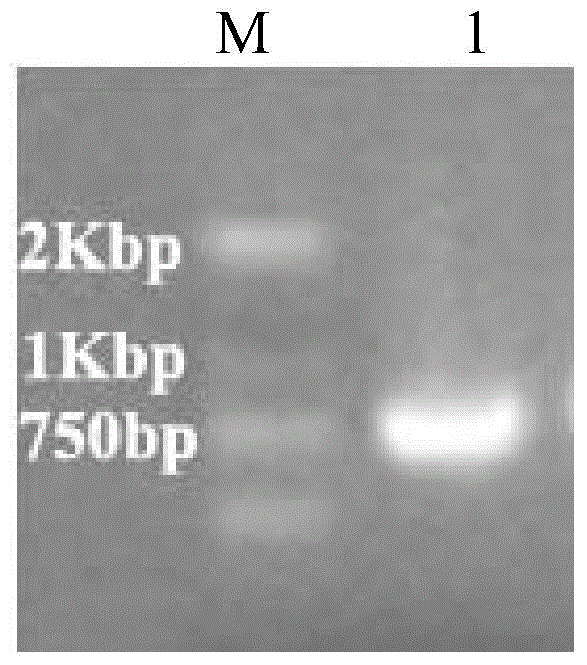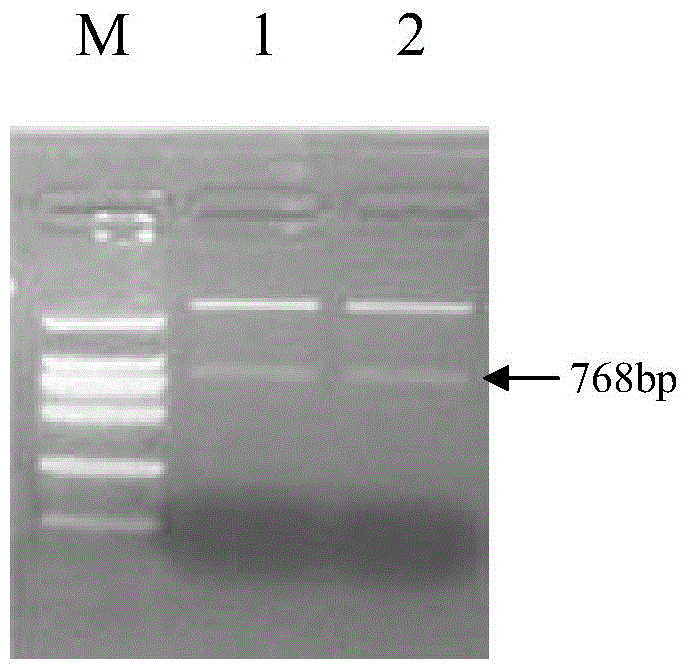Anti-verticillium wilt protein from sea island cotton as well as coding gene and application thereof
A coding and gene technology, applied in the field of genetic engineering, can solve the problems of disease susceptibility or disease resistance, poor disease resistance of Verticillium wilt, and achieve the effect of improved disease resistance and high application value
- Summary
- Abstract
- Description
- Claims
- Application Information
AI Technical Summary
Problems solved by technology
Method used
Image
Examples
Embodiment 1
[0071] Embodiment 1, the acquisition of GbAt11 gene
[0072] 1. Verticillium dahliae V 991 Induced Sea Island Cotton Leaves
[0073] Verticillium dahliae V 991 Cultivate in Cha's medium for 15 days, filter with gauze, count the filtrate with a counting plate under a microscope, and then adjust the spore concentration to 1×10 6 / mL. Take the young leaves of sea island cotton 7124 and soak them in 1×10 6 / mLV991 spore suspension, record the time when the leaves were soaked, and take out the leaves at 0h, 3h, 6h, 12h and 24h after soaking, wrap them in tinfoil, freeze them with liquid nitrogen, and store them in a -80°C refrigerator stand-by.
[0074] 2. Extraction of sea island cotton RNA
[0075] Use the EASYspin Plant RNA Rapid Extraction Kit to extract sea island cotton RNA:
[0076] (1) Mix 500 μl lysis solution RLT (beta-mercaptoethanol has been added) and 50 μl PLANTaid in a 1.5 ml centrifuge tube.
[0077] (2) Grind the sample in liquid nitrogen, transfer about 50...
Embodiment 2
[0099] Example 2, the acquisition and functional analysis of GbAt11 transgenic cotton
[0100] 1. The acquisition and identification of GbAt11 transgenic cotton
[0101] 1. Acquisition of recombinant expression vector pSPT-02-GbAt11
[0102] Design primers At11-Sal1 and At11-KpnI according to the GbAt11cDNA sequence (sequence 2), the sequences are as follows:
[0103] At11-Sal1: 5'-CG GTC GAC ATGTCGATCG CGTTGGAACG-3' (underlined is the Sal I enzyme recognition site, and the subsequent sequence is the 1st to 20th position of sequence 2);
[0104] At11-KpnI:5'-CG GGTACC GTT ATA TTC ACG TAC ATC AGC C-3' (the underlined mark is the Kpn I enzyme recognition site, and the following sequence is the reverse complementary sequence from the 744th to the 765th position of sequence 2).
[0105] Using the recombinant plasmid pMD18-GbAt11 obtained in Example 1 as a template, PCR amplification was performed with primers At11-Sal1 and At11-KpnI.
[0106] After the reaction, the obtai...
Embodiment 3
[0191] Example 3, Obtaining and Functional Analysis of GbAt11 Transgenic Arabidopsis
[0192] 1. Acquisition and identification of GbAt11 transgenic Arabidopsis
[0193] 1. Acquisition of recombinant expression vector super1300-MYC-GbAt11
[0194] Design primers At11-Sal1 and At11-KpnI according to the GbAt11cDNA sequence (sequence 2), the sequences are as follows:
[0195] At11-Sal1: 5'-CG GTC GAC ATGTCGATCG CGTTGGAACG-3' (underlined is the Sal I enzyme recognition site, and the subsequent sequence is the 1st to 20th position of sequence 2);
[0196] At11-KpnI:5'-CG GGTACC GTT ATA TTC ACG TAC ATC AGC C-3' (the underlined mark is the Kpn I enzyme recognition site, and the following sequence is the reverse complementary sequence from the 744th to the 765th position of sequence 2).
[0197] Using the recombinant plasmid pMD18-GbAt11 obtained in Example 1 as a template, PCR amplification was performed with primers At11-Sal1 and At11-KpnI.
[0198] After the reaction, the...
PUM
 Login to View More
Login to View More Abstract
Description
Claims
Application Information
 Login to View More
Login to View More - R&D
- Intellectual Property
- Life Sciences
- Materials
- Tech Scout
- Unparalleled Data Quality
- Higher Quality Content
- 60% Fewer Hallucinations
Browse by: Latest US Patents, China's latest patents, Technical Efficacy Thesaurus, Application Domain, Technology Topic, Popular Technical Reports.
© 2025 PatSnap. All rights reserved.Legal|Privacy policy|Modern Slavery Act Transparency Statement|Sitemap|About US| Contact US: help@patsnap.com



